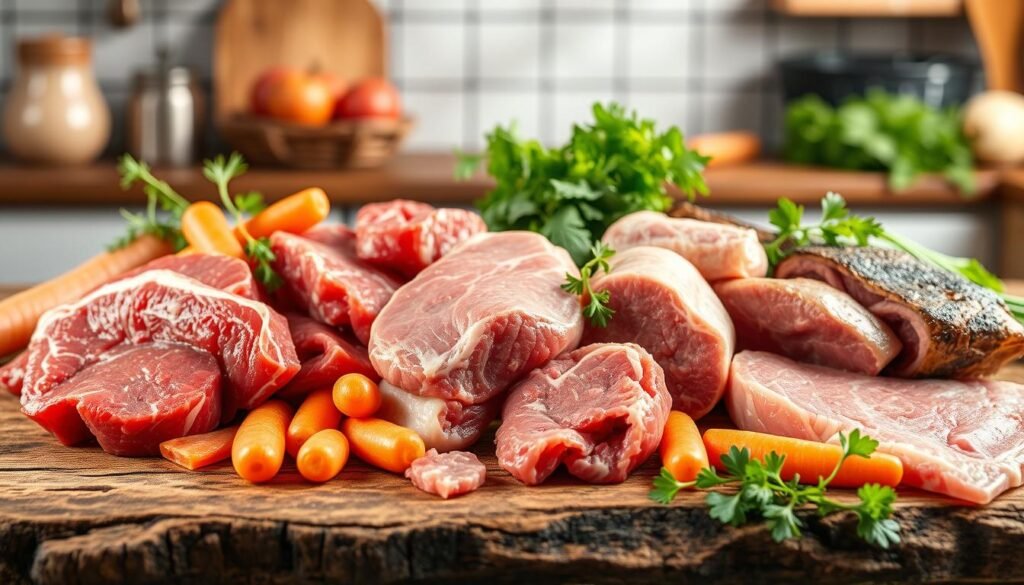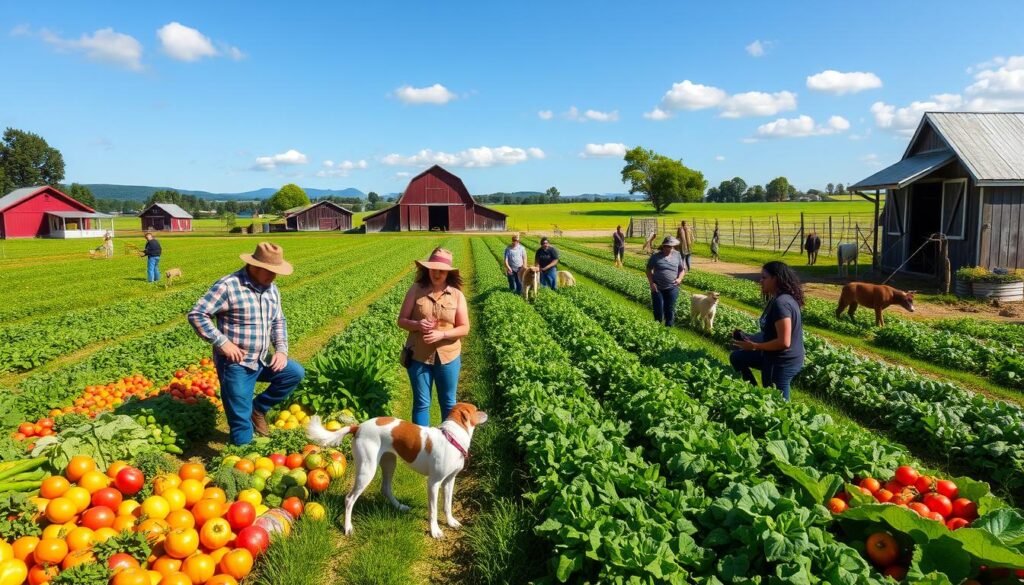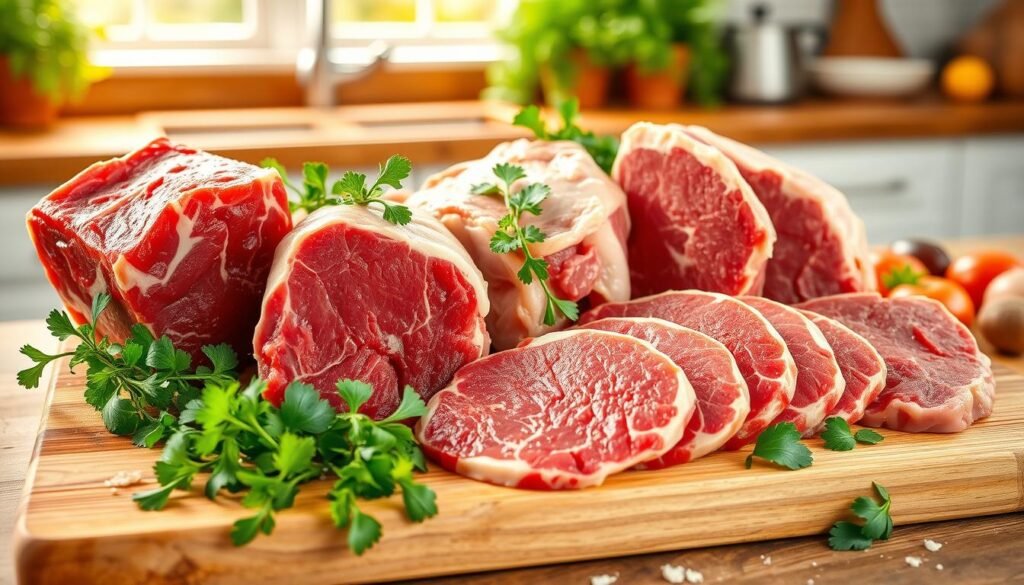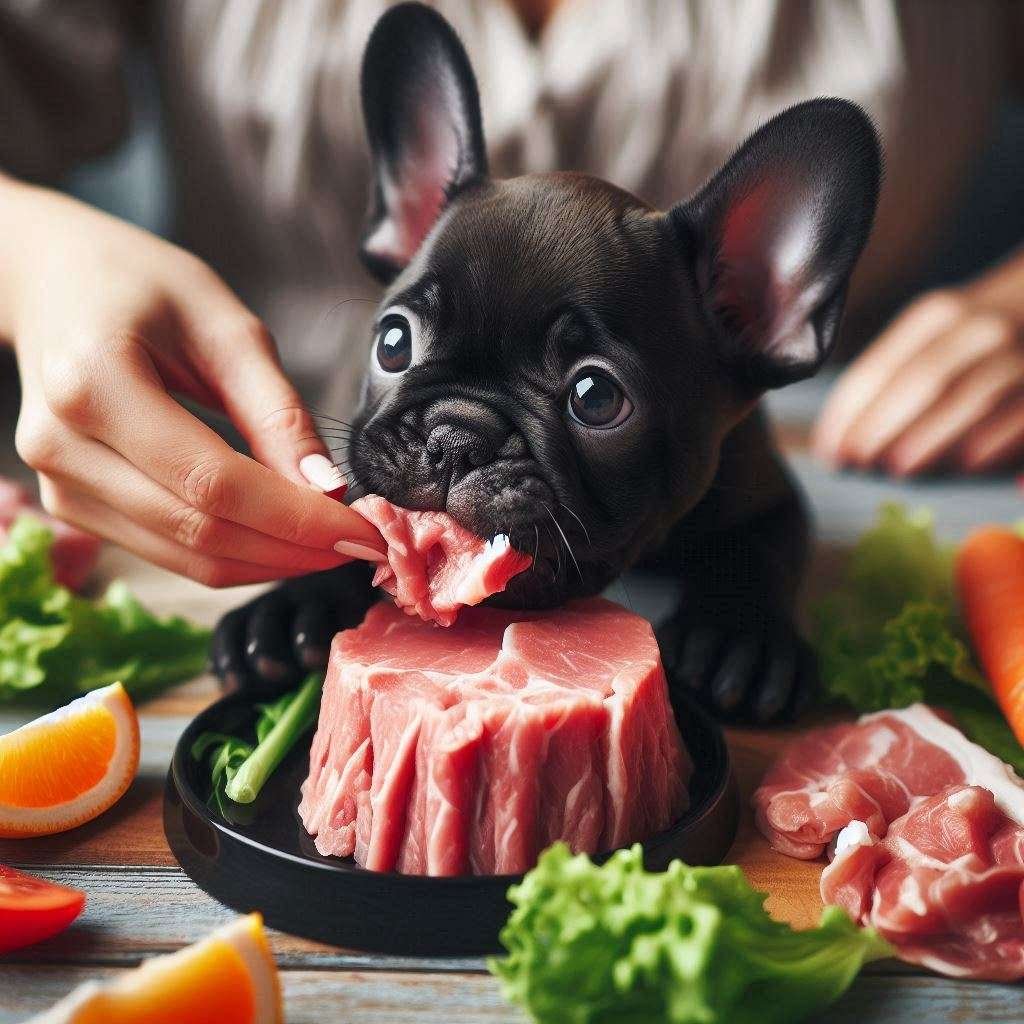Choosing the right raw meat for your dog is key to their health. The Biologically Appropriate Raw Food (BARF) diet is popular for this reason. It includes raw muscle meat, bones, veggies, fruits, and more. These foods are similar to what dogs would eat in the wild.

Key Takeaways
- The BARF diet model recommends a ratio of 70% muscle meat, 10% raw edible bone, 7% vegetables, 5% liver, 5% other secreting organs, 2% seeds or nuts, and 1% fruit.
- Muscle meat provides protein, amino acids, and water-soluble vitamins, while raw edible bones offer calcium, phosphorus, and other essential nutrients.
- Finding local farmers and asking questions about their farming practices can ensure the highest quality raw meat for your dog.
- Buying meat directly from local farmers can benefit the freshness and quality of the meat, as well as support their businesses.
- Recreational bones are essential for a dog’s mental and physical health, but should be provided in addition to a BARF diet.
Biologically Appropriate Raw Foods (BARF) Diet
The BARF diet is a popular choice for dogs. It includes raw muscle meat, bones, veggies, and fruits. This diet aims to meet a dog’s natural diet needs, like what they would eat in the wild.
BARF Model Ratio Guidelines
The BARF diet has a specific ratio for a balanced diet:
- 70% muscle meat
- 10% raw edible bone
- 7% vegetables
- 5% liver
- 5% other secreting organs
- 2% seeds or nuts
- 1% fruit
Muscle Meat
Muscle meat is key in the raw dog food diet. It gives dogs protein, amino acids, and vitamins. Beef, duck, turkey, chicken, lamb, salmon, and white fish are good sources.
Raw Edible Bone
Raw edible bones are important for dogs. They provide calcium, phosphorus, and other nutrients. The right amount of bones in the BARF diet for dogs helps keep bones and teeth strong.
By following the BARF model and using high-quality raw meat protein sources for dogs, pet owners can give their dogs a balanced diet. This diet supports their overall health and well-being.
Sourcing High-Quality Meat for Dogs
Finding local farmers and butchers can make getting raw meat for your dog cheaper and better. By buying meat directly, you ensure your dog gets the freshest, most nutritious food. It’s important to ask the right questions to find the best meat for your dog.
Finding Local Farmers
Look for local raw meat suppliers by checking organic directories and visiting farmers markets. You can also connect with food co-ops or contact your state’s Department of Agriculture. These places can help you find farmers and ranchers who raise animals for both people and pets.
Questions to Ask Farmers
- What are the farming practices used to raise the animals?
- Are the animals pasture-raised, and what are they fed?
- How old are the animals when they are slaughtered?
- Are any hormones, antibiotics, or other additives used?
- Can you provide a certificate of analysis or proof of testing for contaminants?
Asking these questions helps you check the meat’s quality and safety. This ensures your dog gets the best from a BARF diet without risks.
Buying raw meat from local farmers is good for your dog and your community. It supports small businesses and makes feeding your dog more sustainable and ethical.
what raw meat is best for dogs
Choosing the right raw meat for your dog is key to their health. The best raw meats for dogs are those that match their natural diet. They provide important nutrients and help with digestion.
The top raw meats for dogs include chicken, lamb, beef, fish, turkey, and duck. These are full of nutrients and most dogs can easily digest them. Venison and rabbit are also good choices. But, avoid processed meats like sausages and bacon. They can upset your dog’s stomach with their salt and additives.
- Chicken is easy to digest and full of amino acids.
- Lamb is packed with iron, zinc, and vitamins B6 and B12, boosting the immune system.
- Beef is rich in protein and vitamins B12 and iron.
- Fish like salmon and mackerel are great for skin and coat health.
- Turkey is lean and low in fat, a good chicken substitute.
- Duck is flavorful and full of iron and zinc.
It’s important to get raw meat from trusted sources and handle it safely. By choosing the right raw meats and preparing them carefully, you can help your dog stay healthy and thrive on a raw diet.
“The best raw meat for dogs is the one that closely mimics their natural, biologically appropriate diet, providing essential nutrients and supporting optimal digestion.”
Ordering from Butchers
When you order raw meat from a local butcher for your dog, it’s key to give clear cutting instructions. Butchers might not know the special cuts and sizes your dog needs for a balanced diet. So, make sure to tell them exactly what your dog needs.
Cutting Instructions
Here are some tips for cutting your raw meat order:
- Muscle Meat: Tell the butcher to cut big pieces of meat like beef, chicken, or lamb into the right sizes for your dog’s meals.
- Organ Meat: Ask for organ meats like liver and kidney to be cut into smaller pieces. They should be about 10% of your dog’s diet.
- Tripe: Tripe is a nutritious, low-fat option. You can ask for it to be cut into small pieces or ground with other ingredients.
- Raw Meaty Bones: Ask for raw meaty bones like chicken necks or lamb ribs in sizes safe for your dog to eat.
By clearly telling the butcher what you need, you can make sure your dog gets a balanced and tailored raw diet.
Remember, you can thaw larger pieces of meat a bit to make them easier to cut. With a little planning, you can give your dog a healthy and tasty raw diet.
Harvesting and Preparing Raw Meat
Feeding your dog a raw meat diet is very beneficial. But, you must handle the raw ingredients carefully. Here’s a guide on how to properly prepare raw meat for your dog’s meals.
First, find high-quality, fresh meat from local farmers or butchers. When you get the meat home, divide it into individual servings. Cut larger cuts into one-ounce pieces and place them on butcher paper to refreeze. This prevents the portions from sticking together in the freezer.
Don’t forget to include organ meat and raw meaty bones in your dog’s diet. Organ meat, like liver and heart, gives essential vitamins and minerals. Raw meaty bones offer valuable nutrients and help keep your dog’s teeth clean. Package these different components separately for easy meal preparation.
- Portion raw muscle meat into one-ounce pieces and refreeze flat on butcher paper
- Include organ meat and raw meaty bones in your dog’s diet
- Label and date all packages for easy organization and meal planning
Handling raw meat needs the same food safety as human meals. Wash your hands well, sanitize all surfaces and utensils, and avoid cross-contamination. By following these steps, you can give your dog a nutritious raw diet while keeping feeding safe and organized.
“Feeding your dog a raw diet may seem daunting at first, but with a little preparation, it can be a simple and rewarding process. Your canine companion will thank you for the high-quality, nutrient-dense meals.”
Raw Meaty Bones (RMBs) vs Recreational Bones
Raw feeding for dogs has two main types: raw meaty bones (RMBs) and recreational bones. RMBs, like neck bones and oxtails, are soft and easy to chew. They help your dog get important nutrients like calcium and phosphorus.
Recreational bones, such as marrow bones, are harder and bigger. They keep your dog’s mind and body active. But, they shouldn’t be eaten all the way because they’re not meant to be digested.
Both raw meaty bones for dogs and recreational bones are key for your dog’s health. RMBs help with bones and teeth, while recreational bones let your dog chew and explore.
| Raw Meaty Bones (RMBs) | Recreational Bones |
|---|---|
| Softer and non-weight-bearing | Harder and larger |
| Chewed, swallowed, and digested | Provide mental and physical stimulation through chewing |
| Provide essential nutrients, including calcium and phosphorous | Not meant to be fully consumed |
| Support skeletal development and dental health | Satisfy your dog’s natural instinct to chew and explore |
The benefits of raw bones for dogs are many. They give your dog nutrients and keep them happy and healthy. Adding both RMBs and recreational bones to your dog’s diet makes their meals more interesting and balanced.
Benefits of Buying from Local Farmers
Getting raw meat from local farmers is great for your dog’s diet. It’s fresh and of high quality. Plus, it helps your local community grow and stay strong.
Supporting Local Businesses
Buying raw dog food from local farmers strengthens your community ties. These small businesses are crucial to your neighborhood. By choosing them, you help them succeed and boost the local economy.
Buying from local farmers also means you can get to know them. You can ask about their farming methods and ensure the meat is top-notch. This personal touch is rare with big pet food companies.
| Benefits of Buying from Local Farmers | Benefits of Buying from Commercial Suppliers |
|---|---|
|
|
Choosing local farmers for your dog’s food is a smart move. It’s good for your dog and your community. It’s a win-win for everyone.

Honoring the Whole Animal
When you choose raw meat for your dog, it’s key to use the whole animal. This idea is at the heart of the raw feeding movement. It means no part of the animal is wasted, showing respect for its life and giving your dog a diet that’s biologically appropriate.
Many people who follow this diet make sure to use parts of the animal that are often ignored. These include tripe, tongue, trachea, and gullet. These parts are full of vitamins, minerals, and other nutrients that dogs need to stay healthy.
Using the whole animal for raw feeding shows respect for the life given. It also makes sure your dog gets a wide range of nutrients. This approach is a big part of caring for pets in a holistic way. It shows the raw feeding community’s dedication to giving dogs the best.
“The ‘Your dog deserves the best!’ source emphasizes the importance of honoring the whole animal when sourcing raw meat for your dog.”
Following this philosophy means you’re reducing waste and supporting sustainable farming. You’re also giving your dog the most natural and nutritionally-dense diet. It’s good for both your pet and you.
Freshness and Quality for Better Health
Choosing fresh, high-quality raw meat for your dog is crucial. Sourcing from local farmers and butchers ensures your dog gets the best nutrition. This can lead to better health and energy for your pet.
Many pet owners, about a third, cook meals for their dogs. Two-thirds feed raw. Both groups see big health improvements over commercial kibble, with no health issues. This shows that less processed food is better for dogs.
Raw dog food can be 90% meat, offering lots of protein. But, it might be too fatty for some dogs, causing digestive problems. Quality matters here. A Pup Above’s meat is USDA-certified for humans, ensuring safety and nutrition.
Cooked dog foods can also be great. Sous-vide cooking keeps nutrients and makes food more appealing. This is good for dogs who don’t like raw meat.
Whether raw or cooked, focus on freshness and quality. Choose local, human-grade ingredients for the best nutrition. This helps your dog thrive.
“Dogs naturally have a preference for raw meat due to their carnivorous history, and a healthy dog’s digestive system is well-equipped to deal with normal amounts of bacteria present in raw meat.”
Deciding between raw or cooked should be with your vet. They ensure your dog gets the right nutrition. This leads to a happy, healthy life for your pet.

| Metric | Value |
|---|---|
| Customers who cook meals for their pets | 33% |
| Customers who feed raw | 67% |
| Meat content in raw dog food | 90% |
| Meat content in raw cat food | 100% |
Joining the Raw Feeding Community
Starting your dog on a raw diet? You’re in for a treat. The raw feeding community for dogs is full of helpful info and friendly faces. It’s a place where pet owners share their knowledge and love for raw feeding.
Switching to a raw diet can seem scary at first. But don’t worry, you’re not alone. There are many online forums, Facebook groups, and websites ready to help. Seasoned raw feeders are always ready to answer your questions and share their tips.
Being part of the raw feeding community opens up a world of resources. You’ll find articles, videos, and tools to help plan your dog’s meals. It’s a community that understands every dog is different, and they’re here to help you find the right diet for your furry friend.
Whether you’re just starting or have been raw feeding for a while, the community is here for you. You’ll learn about the benefits of raw feeding and get the latest news. Plus, you’ll find the support you need to keep your dog healthy and happy.
“The raw feeding community is a treasure trove of information and support. Connecting with fellow raw feeders has been a game-changer in my journey to provide the best nutrition for my dog.”
So, dive into the conversations and connect with others. Let their experiences and your own knowledge guide you. Your dog’s health and happiness will be the best reward.
Conclusion
In this article, we’ve looked at the benefits of a Biologically Appropriate Raw Food (BARF) diet for dogs. We talked about the right ratio of ingredients and the importance of using high-quality muscle meat and raw bones. It’s also key to get raw meat from local farmers and butchers.
We discussed the different types of raw bones and why using all parts of the animal is important. This approach ensures dogs get a balanced diet that meets their needs.
Moreover, we highlighted the benefits of using fresh, locally-sourced raw meat. This not only improves the quality of the food but also supports the local community. Dog owners can give their pets a diet that’s both nutritious and species-appropriate.
To sum up, the main points for feeding dogs raw include a balanced BARF diet and using high-quality, local meat. It’s also crucial to prepare and store the food safely. With the right steps, raw feeding can be a great way to improve your dog’s health and your relationship with them.


